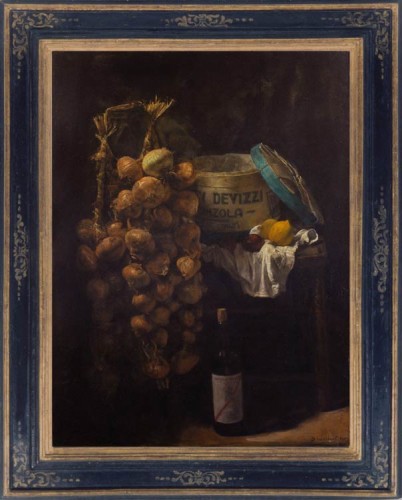In this work, Weissbort seems to be looking again at the paintings of Melendez (1716-80), in which humble items were rendered heroic – in contrast, for instance, to works by the 17th century Willem Kalf. Kalf painted a few arrangements of kitchen implements, but his preferred subjects were glass goblets, silver platters, chased drinking horns and porcelain. Melendez painted the scullery, rather than the dining, table, and several of his works include the same wooden cheese boxes that Weissbort has depicted here – along with lemons, onions and crumpled linen. The earthy colours and dark tonality of the present painting emphasize the old masterly approach, which is undercut by a diagonal stripe of viridian green around the lid of the gorgonzola box: a sudden, sharp note of chemical modernity, provoking an exciting tension within the picture. The fall of light on the bronze sheen of the onions skins is beautifully observed, as is the texture of the box. Note: The Devizzi family produced gorgonzola from 1889 to 1981; viridian green was discovered in 1797, but only used in oil paint from about 1840.
Biographical details
George Weissbort (1928-2013) was born in Belgium and moved to London at the age of 7. He attended the Central School of Art & Design (now St Martin’s) where he was taught by Ruskin Spear and Rodrigo Moynihan. He was influenced by Arthur Segal to move from the abstract expressionism of the 1940s to realism, and by Bernard Meninsky, who taught life drawing at the Central School, to study the Old Masters. He turned first to artists such as Cézanne and Matisse, and later to Vermeer, Chardin, Velasquez, Corot, Titian, Holbein, and Piero della Francesca, amongst others.
He exhibited regularly at the Royal Academy, the Royal Society of Portrait Painters and the Fine Art Society. In 1964-65 he had a large exhibition in Paris, and in 2006 he had a one-man retrospective at the Chambers Gallery, London, followed in 2008 by another at the Denise Yapp Gallery, Whitebrook, Monmouth.
He wrote essays on art and criticism which look both at the techniques of making a painting, and of appreciating a work of art. The latter skill he believed came only after years of consciously training the eye to see as the artist saw, considering for example the ‘negative’ spaces around and between objects. He also discussed the work of specific artists, such as Lucien Freud and Vermeer.
His obituary in The Independent quotes Brian Sewell, a friend, as saying of him that Weissbort ‘painted the right pictures at the wrong time’. His appeal was to those who understood his models and influences; he could be described as a painter’s painter, and the same obituary quotes Paula Rego describing him as ‘a truly honest artist who knows so much about painting’.
Publications: George Weissbort, Paintings and Drawings (Parnassus, 2008), ill. 130 colour plates; includes transcripts of a filmed interview; essays by Tony Rudolph, David Lee and Bernard Dunstan RA.
YouTube video: A tribute to George Weissbort by John French.


